By independence, most countries had only a very modest industrial sector. Only in South Africa, Zimbabwe (formerly known as Southern Rhodesia according to countryaah) and Egypt did industrialization begin before 1960. This meant that African countries faced large investments in order to create the basis of a local industry. The infrastructure, including especially energy facilities, had to be expanded. Dam construction for the use of hydropower was given high priority and was carried out in many places (Aswan, Akosombo, Cabora Bassa). However, there is still a large untapped potential for hydropower in the major rivers. However, the main commercial energy source is oil, and several countries have built oil refineries for locally produced or imported crude oil. Large sums have been spent on the construction of power plants; security of electricity supply is still a problem.
Despite the high priority given to the development of a national industry, Africa’s industrial sector remains modest. The industry is predominantly aimed at the national market and at replacing previous imports with locally produced goods. In most countries, the state has played a significant role in building the industry. With the help of tariffs and import restrictions, protected domestic markets have been created; this protection against imports applies to both national industry and subsidiaries of transnational corporations. This so-called import – substituting industrialization strategy has resulted in the building of a national production in the food, wood, textile and footwear industries. However, it has proved much more difficult to use the same strategy to create national production in durable consumer goods (electrical appliances, means of transport, etc.) and in the heavier industries (cement, steel and machinery). The main problem in the strategy is that the national market is very limited; the purchasing power of, for example, durable consumer goods is limited to a small upper class. The industry can therefore not achieve economies of scale, and the goods become relatively expensive.
Although production has been economically unprofitable, a large number of countries have established state-owned enterprises in the heavier part of the industry. These have strained the state budget and required transfers of financial resources from the agricultural sector to industry. Especially after the international downturn that followed oil price increases in 1972-74 and the subsequent debt crisis, growth in this part of the industry has slowed.
After independence, there has been a great growth in the so-called informal sector, including small industries, often with a craft character.
Apart from industries linked to a modest processing of export raw materials (e.g. pressing of vegetable oil), Africa’s industry is very little export-oriented. Only a few countries have succeeded in an export-oriented industrialization strategy that could take advantage of the low wages. However, such industries are found in Morocco, Tunisia and Mauritius, especially in the textile industry, but in general it has proved difficult to compete with similar industries in eg Southeast Asia. There has therefore been interest in establishing regional collaborations in Africa with a view to a later entry into the world market.
The majority of the actual industry is located in capitals and in the few big cities, while the small industries belong in the suburbs of the cities and around marketplaces in town and on land.
The informal sector
This manufacturing sector consists of small industry, repair companies, other service and trade. Production is flexible and geared to local needs; these are usually companies with less than 10 employees. The small industries are particularly prevalent in the clothing (including tailoring), metal, wood and food industries (eg bakeries and breweries). The informal trade sector consists of a wide-ranging network in which street vendors form an important element. Trade is often dominated by particular ethnic groups and by women (especially in West Africa). Furthermore, the sector consists of small businesses, shoe polishers, hairdressers, etc. on streets and markets. Also in the field of transport, smaller contractors play an important role, as they take advantage of the lack of capacity in the state and larger private transport companies.
The service sector plays a major role for many African families as a source of monetary income; often at least one family member is employed in this sector, possibly when trading in the family’s own products.
The informal sector national economic significance is not known and therefore not included in the calculation of GDP, but it is estimated that småindustrien in the early 1980’s contributed more than 2/3 of total industrial employment in Africa.
Service
In addition to the informal sector, Africa’s service sector consists mainly of a large government sector with many public employees as well as a modest modern service sector in the major cities.
A special part is made up of the tourism industry, which in several countries is a very important source of income. The industry’s most important assets are the national parks in the savannah areas and the ancient monuments in North Africa. Only in a few places is there mass tourism based on sun and beach; the African countries have difficulty competing with e.g. southern Europe in this area.


